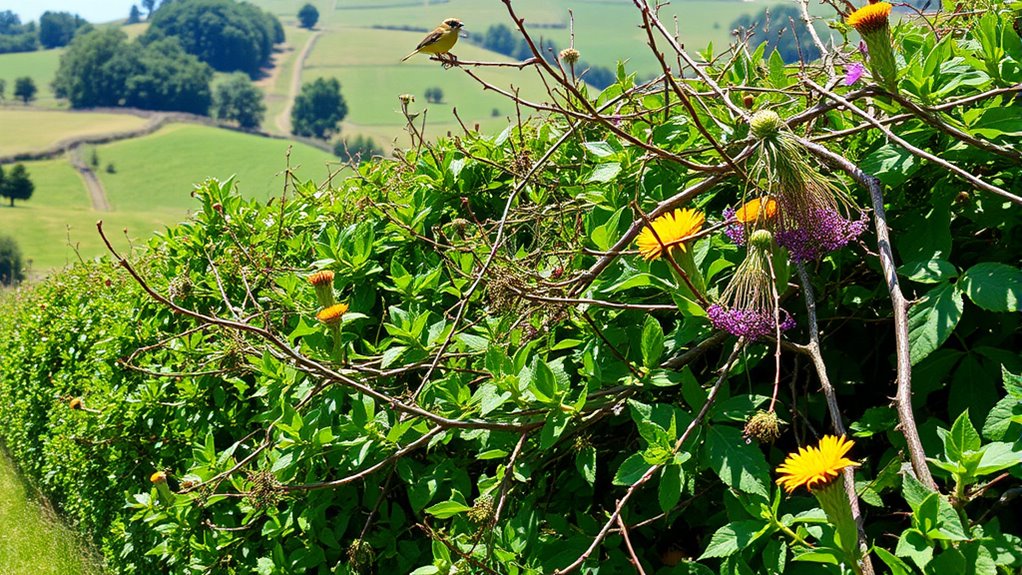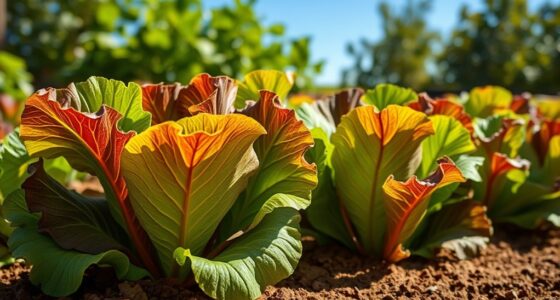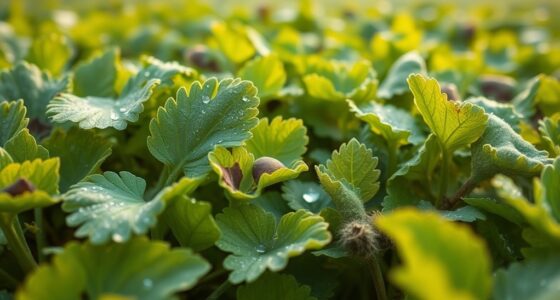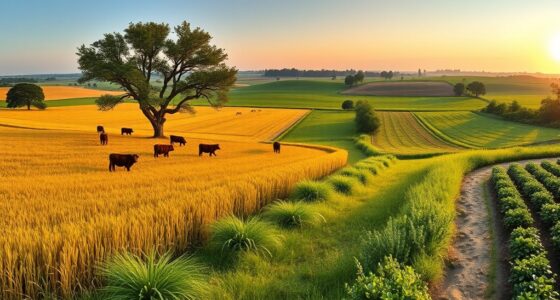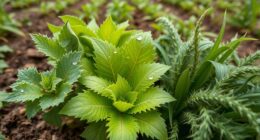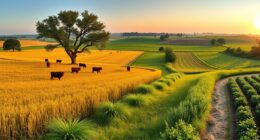To create wildlife-friendly hedgerows that help with pest control, choose native plants with overlapping flowering times to attract beneficial insects and birds year-round. Design your hedgerow with multiple layers—trees, shrubs, and ground cover—to provide shelter and nesting sites. Plant during ideal seasons, keep weeds in check, and avoid pesticides. Regularly manage and maintain the hedgerow, encouraging diverse beneficial species. Keep exploring to discover all the tips for planning and caring for effective pest-fighting hedgerows.
Key Takeaways
- Incorporate native flowering plants to attract pollinators and beneficial insects that naturally control pests.
- Include diverse plant layers and structures to provide shelter and nesting sites for pest predators.
- Maintain year-round bloom cycles to support beneficial insect populations throughout the seasons.
- Minimize pesticide use to protect natural pest control agents and promote ecological balance.
- Design hedgerows with gaps and edges to facilitate movement of beneficial insects and birds that prey on pests.
Selecting Native Plant Species for Hedgerow Diversity

Choosing the right native plant species is essential for creating a diverse and resilient hedgerow. When selecting plants, prioritize species that naturally occur in your region, as they’re best adapted to local soil, climate, and pests. This adaptation helps guarantee healthy growth and reduces maintenance needs. Incorporate a mix of trees, shrubs, and flowering plants to provide food and shelter for various wildlife. Aim for plants that bloom at different times, offering a continuous food source throughout the year. Native species also support local pollinators and beneficial insects, which can help control pests naturally. Understanding the importance of soil moisture management can further enhance plant health and resilience. Avoid non-native or invasive plants, as they can outcompete native species and disrupt local ecosystems. The right selection sets a strong foundation for a thriving, wildlife-friendly hedgerow.
Designing Hedgerows for Maximum Wildlife Habitat
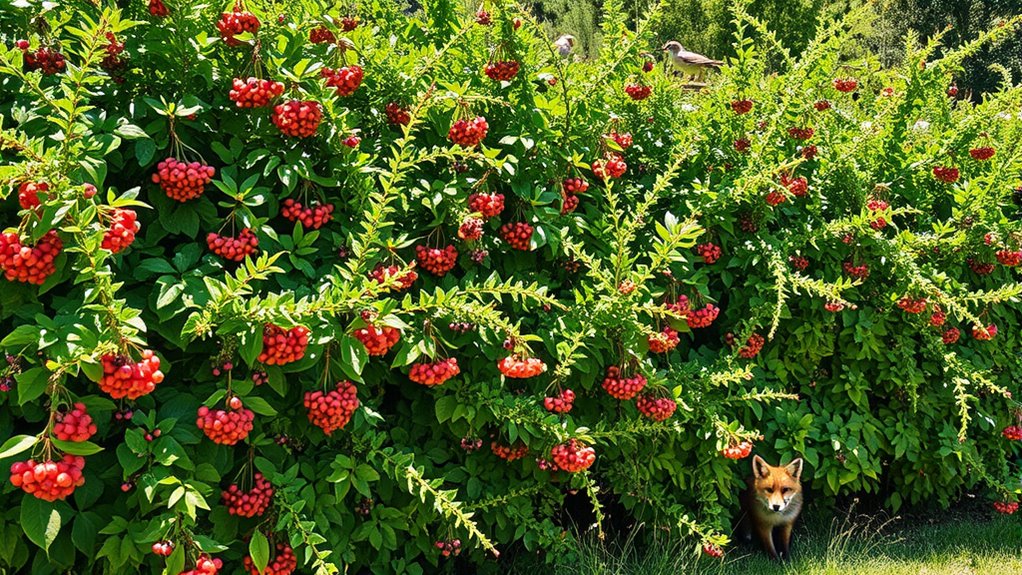
To maximize wildlife habitat, it’s important to thoughtfully design your hedgerow’s structure and layering. Incorporate multiple plant layers—trees, shrubs, and ground cover—to create diverse niches. Vary the heights and densities, allowing different species to find shelter, nesting sites, and food sources. Include gaps and edges to encourage movement and access for wildlife. Use a mix of deciduous and evergreen plants to guarantee year-round cover and resources. Position taller trees at the center or edges, with shrubs around them, and ground cover beneath. This layered approach promotes biodiversity by providing habitats for birds, insects, and small mammals. Properly designed, your hedgerow becomes a resilient, multifunctional habitat that supports pest control and overall ecosystem health.
Planting Techniques and Timing for Establishment
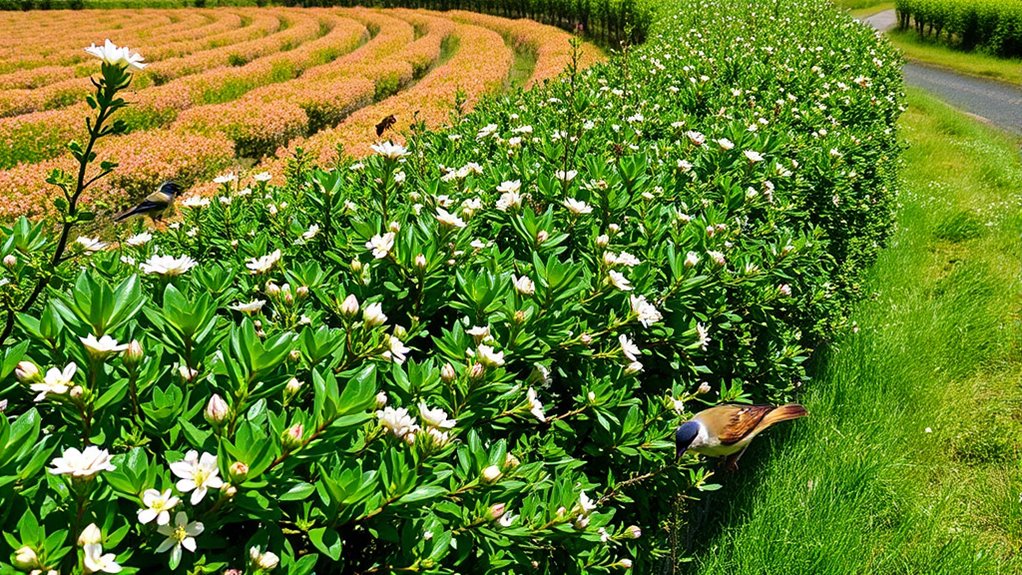
Getting your hedgerow established successfully depends on selecting the right planting techniques and timing. To ensure healthy growth, plant in early spring or late autumn when the soil is moist and temperatures are moderate. Prepare the site by removing weeds and loosening the soil to improve root contact. Use fresh, healthy plants and space them according to species requirements to promote dense growth. Water thoroughly after planting, especially during dry spells. Mulch around the base to retain moisture and suppress weeds. Consider planting a mix of native species for biodiversity and resilience. Be patient—roots need time to establish, so avoid heavy pruning or fertilizing immediately after planting. Proper timing and techniques set the foundation for a thriving, wildlife-friendly hedgerow. Embracing sustainable living can also include creating habitats that support local ecosystems.
Managing and Maintaining Hedgerows for Longevity

Once your hedgerow is established, ongoing management becomes essential to guarantee it remains healthy and functional over the years. Regular pruning helps maintain shape, remove dead branches, and encourage new growth. Keep an eye out for invasive species and remove them promptly to protect native plants. Mulching around the base retains soil moisture and suppresses weeds. Additionally, monitor for pests or diseases and act quickly if issues arise. To organize your tasks, consider this maintenance schedule:
| Task | Frequency | Purpose |
|---|---|---|
| Pruning | Annually or as needed | Shape and promote growth |
| Weed removal | Monthly | Prevent competition |
| Soil health check | Biannually | Ensure proper nutrients |
Regularly observing the health of your hedgerow can help detect early signs of pest infestation, allowing for prompt intervention.
Consistent care guarantees your hedgerow thrives, supporting local wildlife and providing pest control benefits.
Encouraging Beneficial Insects and Birds

Encouraging beneficial insects and birds to visit your hedgerow enhances its ecological value and supports natural pest control. By attracting these helpful creatures, you reduce the need for chemical interventions and promote a balanced ecosystem. To do this, plant a variety of native flowers that provide nectar and pollen, such as wildflowers and herbs. Leave some areas undisturbed to offer shelter and nesting sites. Avoid pesticides that can harm beneficial insects and birds. Incorporate berry-producing shrubs to feed birds year-round. Maintain a mix of plant heights and structures to create diverse habitats. These actions will draw in pollinators like bees and predatory insects, as well as insectivorous birds, naturally managing pest populations and boosting your hedgerow’s health. Additionally, selecting plants that are compatible with electric bikes and dirt bikes can help reduce disturbance and maintain the integrity of your hedgerow environment.
Integrating Hedgerows Into Sustainable Farming Practices

Integrating hedgerows into sustainable farming practices offers a practical way to enhance both productivity and environmental health. By planting and maintaining hedgerows strategically along your fields, you create habitats for beneficial insects, pollinators, and birds that naturally control pests. These living barriers can reduce the need for chemical inputs, lowering costs and minimizing environmental impact. Hedgerows also improve soil stability, conserve water, and filter runoff, supporting overall farm resilience. To effectively incorporate them, plan their placement to align with your crop layout, ensuring they don’t shade or compete with your plants. Regular maintenance, like pruning and native plant selection, keeps hedgerows productive and beneficial. Incorporating organic and natural juices practices such as this can also promote healthier ecosystems and enhance biodiversity on your farm. This integration helps you build a more sustainable, biodiverse, and productive farming system.
Frequently Asked Questions
How Do Hedgerows Impact Local Soil Health and Erosion?
Hedgerows improve local soil health by adding organic matter through leaf litter and plant roots, which enhance soil fertility and structure. Their dense roots stabilize the soil, preventing erosion, especially on slopes or exposed areas. You’ll notice better water retention and reduced runoff, supporting healthy plant growth. By maintaining hedgerows, you actively protect your land from erosion and promote richer, more resilient soil ecosystems.
What Are the Costs Associated With Establishing and Maintaining Wildlife-Friendly Hedgerows?
Establishing and maintaining wildlife-friendly hedgerows costs vary based on size, plant choices, and labor. You’ll spend on native shrubs and trees, initial planting, and possibly fencing. Maintenance involves pruning, weed control, and replacing dead plants, which can add up annually. While costs may seem significant upfront, these hedgerows offer long-term benefits like pest control and biodiversity, making the investment worthwhile. Proper planning helps manage expenses effectively.
Can Hedgerows Be Used Effectively in Urban or Suburban Environments?
In this day and age, hedgerows work well in urban and suburban areas, acting as essential habitats and natural pest controllers. You can plant native shrubs and trees along fences or property boundaries, creating green corridors that attract beneficial insects and birds. This boosts biodiversity and reduces pesticide reliance. With thoughtful planning, hedgerows seamlessly integrate into cityscapes, offering ecological benefits while enhancing your property’s aesthetic appeal and supporting local wildlife.
How Do Hedgerows Influence Neighboring Land Use and Crop Yields?
Hedgerows positively influence neighboring land use and crop yields by acting as natural pest barriers, reducing the need for chemical pesticides, and promoting biodiversity. They encourage beneficial insects and birds, which help control pests more effectively. You’ll notice improved crop health and higher yields over time, as hedgerows enhance soil stability, conserve moisture, and create a balanced ecosystem. This sustainable approach benefits both your land and the environment.
Are There Legal or Regulatory Considerations for Planting Hedgerows?
Yes, there are legal and regulatory considerations when planting hedgerows. You need to check local, regional, and national laws, especially if your hedgerow borders public land or protected areas. You might require permits or need to follow specific guidelines for planting, maintaining, or removing hedgerows. Additionally, consider farm subsidy rules or conservation programs that could influence your planting choices and management practices. Always consult relevant authorities beforehand.
Conclusion
By creating wildlife-friendly hedgerows, you might just turn your farm into a pest control paradise—ironically, by encouraging nature’s own pest fighters. As you plant native species and design habitats, you’ll attract beneficial insects and birds that naturally keep pests at bay. Instead of relying on chemicals, your hedgerows become the silent, thriving guardians of your crops. Who knew that a simple row of bushes could transform your farm into an ecological fortress?

